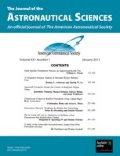Abstract
Classical Floquet theory describes motion near a periodic orbit. But comparing Floquet theory to action angle methods shows which Jordan form is desirable. A new eigenvector algorithm is developed ensuring a canonical transform and handling the typical for the case of repeated eigenvalues, a chronic problem in conservative Hamiltonian systems. This solution also extends the Floquet decomposition to adjacent trajectories, and is fully canonical. This method yields the matrix of frequency partial derivatives, extending the solution’s validity. Some numerical examples are offered.

Similar content being viewed by others
References
Wiesel, W.E.: Earth satellite orbits as KAM Tori. J. Astronautical Sciences 56, 151–162 (2008). https://doi.org/10.1007/BF03256546
Wiesel, W.E.: Low eccentricity earth satellite KAM Tori. J. Astronautical Sciences 62 (3), 197–211 (2015). https://doi.org/10.1007/s40295-015-0077-6
Wiesel, W., Pohlen, D.: Canonical floquet theory. Celestial Mechanics and Dynamical Astronomy 58, 81–96 (1994). https://doi.org/10.1007/BF00692119
Acknowledgments
The author wishes to gratefully acknowledge the support of the Air Force Research Laboratory, AFRL/RV. No financial conflicts of interest arise out of this work.
Author information
Authors and Affiliations
Corresponding author
Additional information
Publisher’s Note
Springer Nature remains neutral with regard to jurisdictional claims in published maps and institutional affiliations.
Appendix: Appendix: Iterative Improvement
Appendix: Appendix: Iterative Improvement
For the earth orbit zonal potential problem, earlier methods sufficed to reduce the errors in the eigenvector problem and the symplectic condition to order 10− 5 − 10− 7. The oscillatory mode is calculated by a standard eigenvalue package, and since its frequency is quite small, it lies very close to the four times repeated eigenvalue of 1 + 0i in the complex plane. The two eigenvectors obtained by rescaling the velocity vector and a z axis infinitesimal rotation, are calculated about as accurately as any quantity in this problem, and are much to be preferred to accepting their values from the eigenvector routine. So, it is time to look at the problem as a whole. The canonical eigenvalue / vector problem then come down to satisfying the eigenvalue equation
while also satisfying the symplectic condition for normalization
Once the eigensolution is close, it is possible to use a Newton-Rhapson algorithm to improve it. Calculating differentials of the symplectic condition yields
after expanding about the current best solution. As the symplectic condition is fully antisymmetric, it only contributes fifteen independent equations. Similarly, the eigenvalue equation expands as
where \( \vec p \) is the vector of four parameters that specify the normal form matrix \( \mathcal {J} \).
The first two coordinate vectors, derived by rescaling displacements in time and polar rotation, and sanctioned by known exact integrals of the dynamics, are to be presumed correct. That means the remaining problem is to correct the two extended eigenvectors and the two oscillatory mode vectors to satisfy Eqs. 30 and 31 more exactly. Holding the first two columns of E constant leaves twenty four unknown elements of the E matrix, and four unknowns for the normal form matrix, for a total of twenty eight quantities to be corrected. Implementing Eqs. 32 and 33 supplies more equations than are needed. But decomposing this linear system with a singular value decomposition, it is found that the actual rank is the required 28, and a Moore-Penrose solution is possible.
Figure 2 shows the symplectic accuracy achieved for a sample of periodic orbits in a 20th order geopotential, with and without iterative improvement in the symplectic eigenvalue / eigenvector problem. Iterative improvement gains about four orders of magnitude in accuracy, and approaches the expected double precision limit. A check on the closure of the periodic modal matrix E shows a similar improvement. The propagation of this matrix via (7) depends on the accuracy of the Jordan form.
Rights and permissions
About this article
Cite this article
Wiesel, W.E. Canonical Floquet Theory II: Action-Angle Variables Near Conservative Periodic Orbits. J Astronaut Sci 68, 391–401 (2021). https://doi.org/10.1007/s40295-021-00258-z
Accepted:
Published:
Issue Date:
DOI: https://doi.org/10.1007/s40295-021-00258-z




